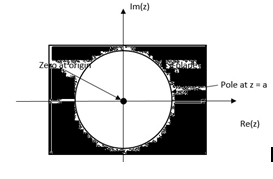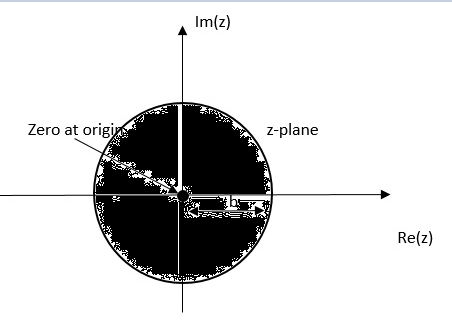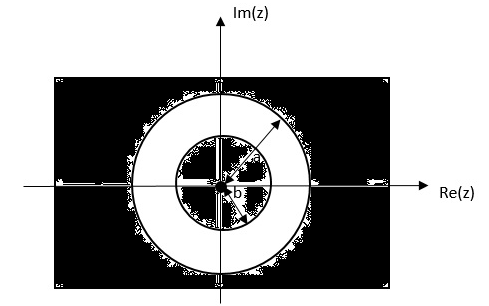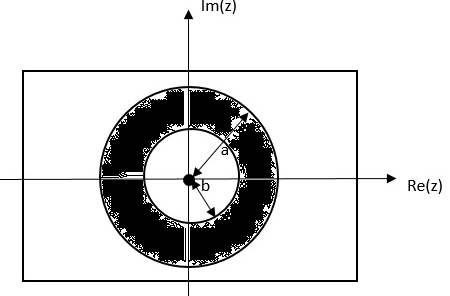Unit - 2
Z-Transform and Its Application to the Analysis of LTI Systems
Due to its convolution property, the z-transform is a powerful tool to analyse LTI systems

As discussed before, when the input is the eigenfunction of all LTI system, i.e.,
 ,
,
The operation on this input by the system can be found by multiplying the system's eigenvalue H(z) to the input:

Causal LTI systems
An LTI system is causal if its output y(n) depends only on the current and past input x(n) (but not the future). Assuming the system is initially at rest with zero output y(n) =0 for n<0, then its response y(n)=h(n) to an impulse x(n)= δ(n) at n=0 is at rest for n<0, i.e., h(n)= h(n)u(n). Its response to a general input x(t) is:

Due to the properties of the ROC, we know that
If an LTI system is causal then the ROC of its transfer function H(z) is the exterior of a circle including infinity. In particular, when H(z) is rational, then the system is causal if and only if its ROC is the exterior of a circle outside the out-most pole, and the order of numerator is no greater than the order of the denominator.Note the requirement for the orders of the numerator and denominator guarantees the existence of H(z) even when z=∞
Stable LTI systems
An LTI system is stable if its response to any bounded input is also bounded for all n
If  then
then 
As the output and input of an LTI is related by convolution, we have:

And

which obviously requires:

In other words, if the impulse response function h(m) of an LTI system is absolutely integrable, then the system is stable. We can show that this condition is also necessary, i.e., all stable LTI systems' impulse response functions are absolutely integrable. Now we have:
An LTI system is stable if and only if its impulse response is absolutely summable, i.e., the frequency response function H(ejω) exits, i.e. the ROC of its transfer function H(z) includes the unit circle |z| = 1.

Causal and stable LTI systems
From the two properties above, we also see that
A causal LTI system with a rational transfer function H(z) is stable if and only if all poles of H(z) are inside the unit circle of the z-plane, i.e., the magnitudes of all poles are smaller than 1.

Example:
The transfer function of an LTI is

As shown before, without specifying the ROC, this H(z) could be the z-transform of one of the two possible time signals h(n).
If ROC is |z|>a, the system h[n]=an u[n] is causal.
If |a|<1, i.e., unit circle can be included in ROC, the system is stable
If |a|>1, i.e., unit circle cannot be included in ROC, the system is unstable
If ROC is |z|<|a|, the system h[n]=-an u[-n-1] is anti-causal.
If |a|<1, i.e., unit circle cannot be included in ROC, the system is unstable
If |a|>1, i.e., unit circle can be included in ROC, the system is stable
Key takeaway
| |a|<1 | |a|>1 |
|z|>|a| | ejω inside ROC | ejω outside ROC, |
h[n]=ean u(n) | causal, stable | causal, unstable |
|z|<|a| | ejω outside ROC | ejω inside ROC, |
h[n]=-an u[-n-1] | anti-causal, unstable | anti-causal, stable |
The most important use of z-transform is its ability to completely characterise signals and linear systems in the most general ways possible. The z-transform is primarily used to convert the discrete time domain signal into discrete frequency domain signal. The z-transform for LTI system is defined as
H(z)=
The range of variation of z for which z-transform converges is called region of convergence of z-transform.
Properties of ROC of Z-Transforms
R1 <|z| < R2
Rmin < |z| <Rmax.
Where R1, R2 are the magnitude of two poles of x(z)
Key takeaway
ROC does not contain any pole.
Example-1 Find the z-transform of the signal x(n) = sin w0n u(n) and find ROC.
A1) X(z) = 
X(z) = 
=  sin
sin  = ej
= ej - e-j
- e-j / 2j
/ 2j
= 1/2j  (ejw0n – e –jwon )z-n
(ejw0n – e –jwon )z-n
= 1/2j  ejwon z-1) n -
ejwon z-1) n -  e-jw0z-1) n
e-jw0z-1) n
1/2j[ 1/1-ejw0z-1 – 1/1-e-jw0z-1]
= sin w0 z-1/ 1-2cos(wo)z-1 + z-2 ROC |z| >1
Linearity
If X1(z) = Z{x1(n)} and X2(z) = Z{x2(n)}
Then
Z{ax1(n) + bx2(n)} = a X1(z) + b X2(z)
Proof:
Z{ax1(n) + b x2(n) }=  z-n
z-n
= a  z-n + b
z-n + b  z-n
z-n
= a X1(z) + b X2(z)
Time Shifting
If X(z) = Z{x(n)} and initial conditions for x(n) are zero then
Z{x(n-m) } = z-m X(z)
Where m is a positive integer.
Proof:
Z {x(n-m)} =  z-n
z-n
Let n-m = p then n= p+m
Z{x(n-m)} =  z –(m+p)
z –(m+p)
z-m  z-p = z-m X(z)
z-p = z-m X(z)
Multiplication by exponential sequence
If X(z ) = Z{x(n)} then
Z [ an x(n) ] = X(a-1 z)
Proof:
Z{ an x(n) } =  an z-n
an z-n
=  (az-1)n
(az-1)n
= X(az-1)
Convolution
We know that
Z{x(n) * h(n) } = X(z) H(z)
Proof:
Let y(n) = x(n) * h(n)
y(n)= 
Taking z-transform on both sides we obtain
Y(z) =
 z-n
z-n
 z-k
z-k  z –(n-k) Replacing n-k by l
z –(n-k) Replacing n-k by l
 z-k
z-k  z-l
z-l
= X(k) Z(k)
Time Reversal
If X(z) = Z{x(n)} then
Z{x(-n)} = X(z-1}
Proof:
Z{x(-n)} =  ( z-l) -1 l=-n
( z-l) -1 l=-n
= X(z-1)
Multiplication by n
If Z{x(n)} = X(z) then
Z{n x(n)} = -z d/dz X(z)
X(z) = 
Z{n x(n)} = 
= z  -1
-1
= z 
= -z  }
}
= -z d/dz { 
= -z d/dz X(z)
Key takeaway
Property | Time Domain | z-Domain | ROC |
Notation |
|
|
|
|
|
|
|
Linearity |
|
| At least |
Time shifting |
|
| At least ROC, except |
z-scaling |
|
|
|
Time reversal |
|
|
|
Conjugation |
|
| ROC |
z-differentiation |
|
|
|
Convolution |
|
| At least |
Problems:
x(n) = a n-1 u(n-1)
We know that x(n) = an u(n) is
X(z) = 1/1/az-1
By using time shifting property we have Z{ x(n-k)} = z-k X(z)
Therefore
Z{an-1 u(n-1)} = z-1/ 1-az-1 = 1/z-a. ROC |z| > |a|
2. Find the z-transform of the sequence
x(n) = an cos nπ/2
Z{ cos w0n} = 1- (cos w0) z-1/ 1 –(2 cos w0) z-1 + z-2
Since w0=π/2
Z{ cos π/2 n u(n)} = 1/1 + z-2
Using exponential sequence property
Z{ an x(n) } = X(a-1 z)
Z{ an cos nπ/2} = 1/1+(a-1z)-2 = 1/ 1 + a2/z2 = z2/ a2 + z2
3. Find the z transform of the sequence x(n) = n u(n)
The z-transform of unit step sequence is given by
Z{u(n)} = z/z-1
Z{ n u(n)} = -z d/dz (z/z-1)
= z/(z-1)2
4. If x(n) = x1(n) * x2(n) where x1(n) = (1/3)n u(n) and x2(n) = (1/5)n u(n). Find X(z) by using convolution property.
X1(z) = 1/ 1- (1/3)z-1 X2(z) = 1/1- (1/5) z-1
X(z) = 1/1-(1/3)z-1 . 1/1-(1/5) z-1
Using z-transform find the convolution of two sequences.
x1(n) = {1,2,-1,0,3} x2(n) = { 1,2,-1}
Z{ x1(n) * x2(n)} = X1(z) . X2(z)
X1(z) = 1 + 2z-1 – z-2 + 3 z-4
X2(z) = 1 + 2z-1 – z-2
(1 + 2z-1 – z-2 + 3 z-4 ) (1 + 2z-1 – z-2 )
= 1 + 4z-1 + 2z-2 – 4 z- 3 + 4 z-4 + 6 z- 5 – 3 z-6
5. Determine the z-transform of the signal
x(n ) = rn (sin w0n ) u(n)
Z{(sin w0n ) u(n)} = sin w0 z-1/ 1 -2 (cos w0) z-1 + z-2
Z{ an x(n)} = X(a-1 z)
Therefore
Z{ rn sin(w0n) u(n) } = (sin w0) (r-1 z)-1/ 1- 2 (cos w0)(r-1z)-1 + (r-1z)-2
= r(sinw0) z-1/ 1-2r(cos w0) z-1 + r2 z-2
6. Determine the signal x(n) whose z-transform is given by
X(z) = log(1- az-1).
X(z)= log(1-az-1)
Differentiating both sides we get
d/dz X(z) = 1/1-az-1 (a z-2) = az-2/1- az-1
-z d/dz { X(z)} = -az-1/1-az-1
= -az-1[ 1/1-az-1]
= -a Z[ a n-1 u(n-1)] -------- (1)
From differentiation property
Z{ n x(n)} = -z d/dz [ X(z)] ------- (2)
Comparing (1) and (2) we get
n x(n) = -a [ a n-1 u(n-1)]
or x(n) = -a [a n-1 u(n-1)]/n
7. Determine the z-transform of the signal
x(n) =1/2 (n2 + n) (1/3) n-1 u(n-1)
=½ n2 (1/3) n-1 u(n-1) +1/2 n (1/3) n-1 u(n-1)
We know that
Z[(1/3) n u(n)] = z/ z-1/3
Using time-shifting property
Z{(1/3) n-1 u(n-1)] = 1/ z- 1/3
Z [ n (1/3) n-1 u(n-1)] = -z d/dz [1/z-(1/3)]
=-z d/dz( 1/z-1/3)= -z [-1/(z-1/3) 2]= z/ (z-1/3)2
Z [ n2 (1/3) u(n-1)] = -z d/dz [ z/(z-1/3)2]
= z(z+1/3)/(z-1/3)2
= -z [ (z-1/3)2 -2z(z-1/3)/(z-1/3)4
= z(z+1/3)/(z-1/3)3
X(z) = ½[z(z+1/3)/(z-1/3)3 + z/ (z-1/3)2]
= z2/(z-1/3)3
Formal inverse z-transform is based on a Cauchy integral
• Less formal ways sufficient most of the time – Inspection method – Partial fraction expansion – Power series expansion
• Inspection Method – Make use of known z-transform pairs such as
anu[n] 1/ (1-az-1) |z| > |a|
Find the z-transform for the sequence
x[n] = 2  + 3
+ 3  + 5
+ 5  + 2
+ 2 
Solution:
X(z) = 2 + 3 z-1 + 5 z -2 + 2 z -3
If X(z)= 4 – 5 z-2 + z-3 – 2z -4 then find x[n]
Solution:
x[n] = 4  - 5
- 5  +
+  - 2
- 2 
Find the z-transform and ROC of the signal
x(n) = an u(n)
Solution:
X(z) = 
=  an u(n) -----(1) u(n) = 0 for n<0
an u(n) -----(1) u(n) = 0 for n<0
1 for n≥0
=  an ------- (2)
an ------- (2)
=  n ------- (3)
n ------- (3)
This is a geometric series of infinite length that is
a + ar + ar2 + ………….. ∞ = a /1-r if |r| <1
Then from equation (3) it converges when |az-1| < 1 or |z| >|a|
Therefore
X(z) = 1/ 1-az-1: ROC |z| > |a|

Fig 2 ROC |z|>|a|
Find the z-transform of the signal x(n) =-b n u(-n-1). Find ROC
X(z) = 
X(z) =  bn u(-n-1) u(-n-1) =0 for n ≥0
bn u(-n-1) u(-n-1) =0 for n ≥0
= 1 for n ≤ -1
=  bn =
bn =  b-1
b-1
= b-1z/1- b-1z = z/ z-b = 1/ 1-bz-1 |z| < |b|

Fig 3 ROC |z|<|b|
Find the z-transform of x(n) = an u(n) – bn u(-n-1)
X(z) = 
=  n +
n +  b-1
b-1
= z/z-a + z/z-b ROC |a| < |z| < |b|

Fig 4 ROC |a| < |z| < |b|
|b|< |a|

Fig 5 ROC |b|< |a|
|b| >|a|
Find the z-transform of x(n) = {1,2,3,2}
Given x(0) = 1 x(1) =2 x(2) =3 x(3) = 2
X(z) = 
X(z) = 1+ 2z-1 + 3 z-2 +2 z-3
Formal inverse z-transform is based on a Cauchy integral
• Less formal ways sufficient most of the time – Inspection method – Partial fraction expansion – Power series expansion
• Inspection Method – Make use of known z-transform pairs such as
anu[n] 1/ (1-az-1) |z| > |a|
Power series method
The z-transform of the sequence x(n) is given by

gives the expansion in power series form. From power series we get the following sequence:
x(n) = {∙∙∙∙∙∙∙∙∙∙x(−2), x(−1), x(0), x(1), x(2), ∙∙∙∙∙∙∙∙∙∙∙}
It is possible to get the power series expansion directly or by long division. In power series expansion technique ROC has a vital role.
Find the partial fraction method of
X(z) = ¼ z-1
(1 – ½ z-1)(1-1/4 z-1)
X(z) = A + B
Z (1-1/2z-1) (1 – ¼ z-1)
By solving A= 1 and B=-1
Therefore,
X(z) = z - z
z-1/2 z-1/4
x(n) = (1/2) n u(n) – (1/4) n u(n)
Find the partial fraction of
X(z) = 1
1+ z-1 + z-2
X(z) = z
z2 + z + 1
= z
(z + 0.5 +j 0.866)(z+0.5 – j0.866)
X(z) = c + c*
z z-(-0.5 +j0.866) z – (- 0. 5 – j 0.866)
X(z) = 0.5+j0.288 + 0.5 – j 0.288
z z-(-0.5 +j0.866) z – (- 0. 5 – j 0.866)
X(z) = 0.5+j0.288 z + 0.5 – j 0.288 z
z-(-0.5 +j0.866) z – (- 0. 5 – j 0.866)
By taking inverse z-transform both sides we get
= (0.5+j0.288)( (-0.5 +j0.866) n u(n) +(0.5+j0.288)( (-0.5 -j0.866) n u(n)
Key takeaway
The methods used for finding inverse z-transform are partial fraction method and power series method.
Due to its convolution property, the z-transform is a powerful tool to analyse LTI systems. From convolution property Y(z)=H(z)X(z).
Where:
Y(z)= z-transform of system output
H(z) = z-transform of impulse response
X(z)= z-transform of system input
A discrete time LTI system is causal if and only if the ROC of its system function is exterior of the circle including infinity. The ROC is the exterior of the outermost pole. H(z) is the ratio of polynomials in z, the order of numerator cannot be greater than the order of the denominator.
The LTI system is stable if and only if the ROC of the system function H(z) includes the unit circle |Z|=1. If it is a causal system, it will be stable if and only if all he poles of H(z) lie inside the unit circle. Section 2.1 deals with detailed explanation.
Key takeaway
It is possible for the system to be stable but not causal.
Reference































